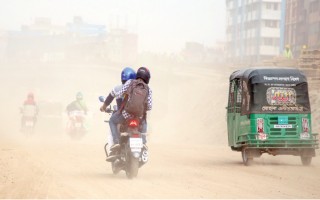Air quality falls in capital
The capital’s air quality deteriorated after implementing a Tk 802.25 crore air quality improvement project in nine years since 2009.
The project cost included Tk 769.74 crore provided by the World Bank as credit carrying 0.75 per cent service but no interest.
The Tk 802.25 crore clean air and sustainable environment project for the capital was implemented by the Ministry of Environment, Forests and Climate Change.
Under the project the implementing ministry engaged the two city corporations, the Department of Environment and Dhaka Transport Coordination Authority to construct roads, sidewalks, foot-over-bridges, passengers sheds at bus stops and installing traffic signals.
The feasibility studies for introduction of Bus Rapid Transit linking the Hazrat Shahjalal International Airport and Mohakhali was carried out by Dhaka Transport Coordination Authority with money from the clean air and sustainable environment project.
The Department of Environment opened 11 air quality monitoring stations with money from the same project.
The DoE conducted studies for innovating brick kilns capable of emitting less carbon also spending money from the project for the capital’s air quality improvement and sustainable environment.
On February 17, 2014, when air quality monitoring began, the capital’s air quality was unhealthy with an average air quality index value of 172.
On Saturday the capital’s air quality was ‘very unhealthy’ with average air quality index value of 264.
The World Health Organization set the standard air quality index value at 50.
At midnight the capital’s air quality index value often crosses 300, which is considered by the WHO as ‘extremely unhealthy’.
In 2018, the Bangladesh capital was ranked by the US Environmental Protection Agency as the world’s 4th most polluted city with average annual air quality index value of 195.
Since 2014, average fine particles suspended in the capital’s air increased four times, Dhaka University chemistry professor Abdus Salam, who studied the problem for years, told new Age.
‘The fine particles suspended in our capital’s air is eight times higher than the WHO set standard of 25 microgram per cubic metre, indicating high level of carbon, sulfite, nitrate and heavy mineral like chromium and lead in the air,’ he said,
Jatiya Shshtya Adhikar Andolan president Dr Rashid-E-Mahbub said, ‘Polluted air is extremely harmful for the public as it might cause chronic skin, lung, kidney, stomach and other diseases besides failure of organs.’
The Transparency International, Bangladesh as well as environmentalists questioned the logic of implementing an unproductive clean air and sustainable environment project spending public money and WB credit.
They called it illogical to spend Tk 461 crore for construction of roads, sidewalks, drains, foot bridges, passengers sheds at bus stands and installation of traffic signals by the capital’s two city corporations.
They called it totally illogical to spend Tk 54.48 crore on feasibility studies for a proposed bus rapid transit project.
‘The bureaucrats who misled the government for taking such projects should be punished for wasting scarce funds,’ said architect and joint secretary of Bangladesh Paribesh Andolon Iqbal Habib.
‘I am surprised over how the World Bank could extend loan for the construction of foot bridges, footpaths, passenger sheds at bus stands and the installation of traffic signals under clean air project,’ he said.
TIB’s executive director Iftekharuzzaman said that for implementing ineffective and inappropriate project like this, the government was denied grants from the climate resilience trust fund.
Environment ministry additional secretary M Mozahed Hossain refuted all the criticism saying the project was taken to mitigate adverse impacts of climate change and environmental degradation.
He said that roads, footpaths, foot bridges, drains were constructed to ease the capital’s traffic congestion as it emits lot of carbon.
In her written reply, World Bank media relations officer Mehrin Mahbub claimed air pollution remained stable despite increased population and economic activities.
News Courtesy: www.newagebd.net











